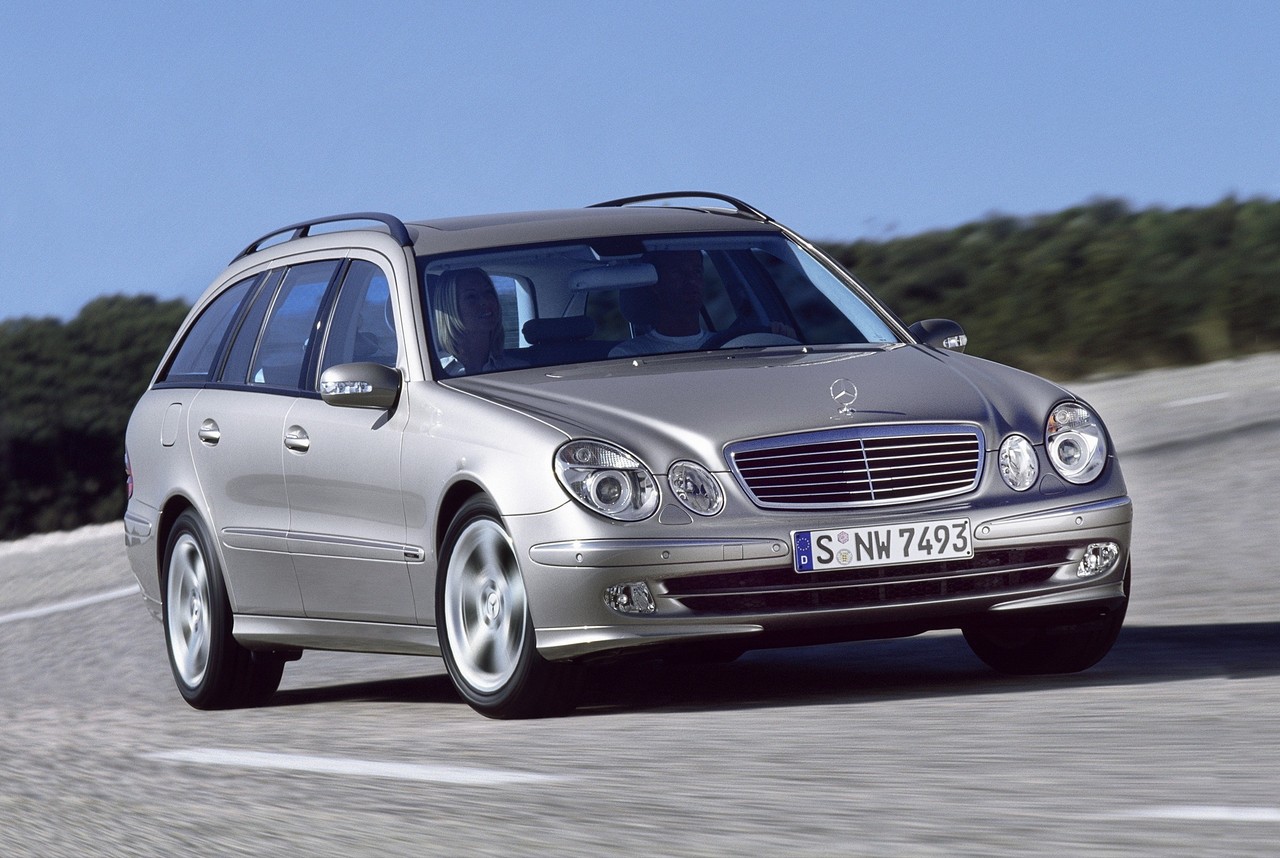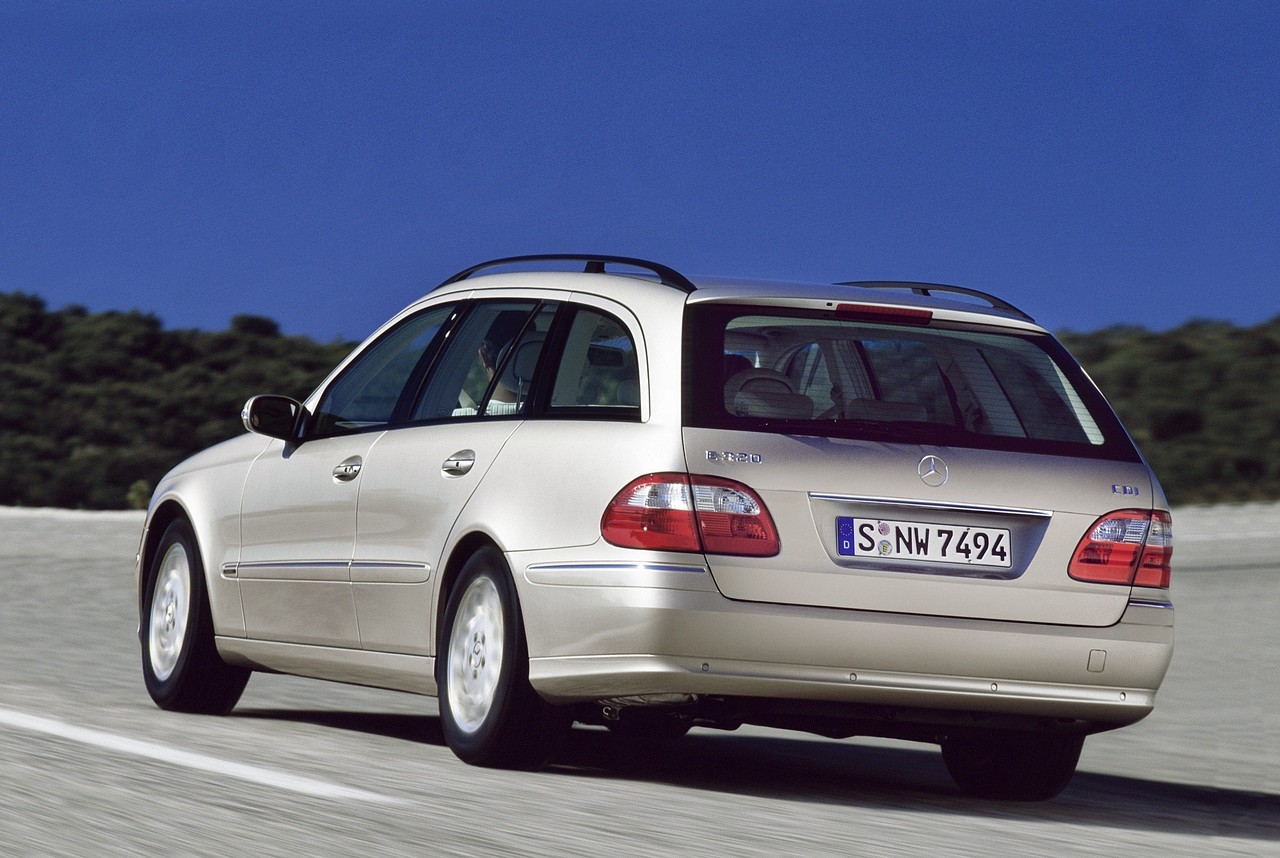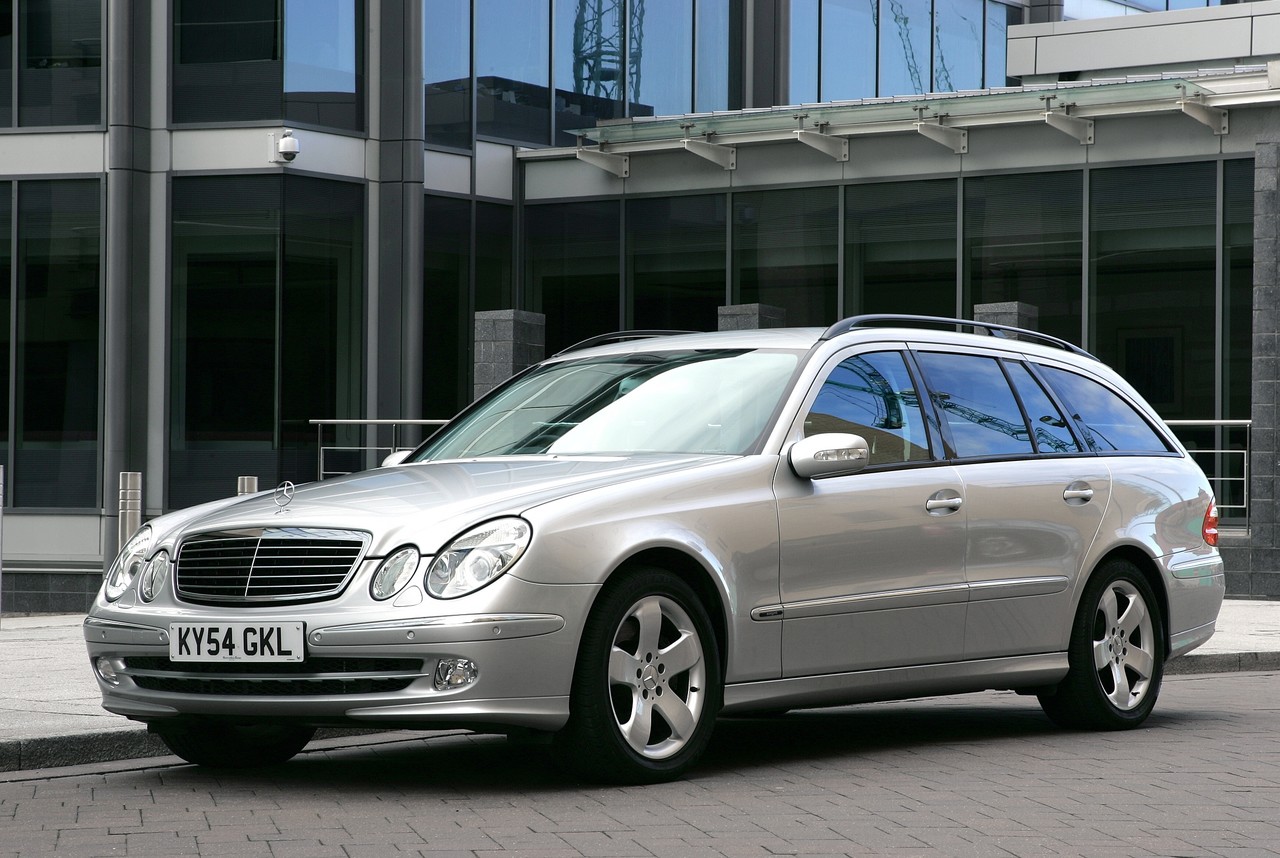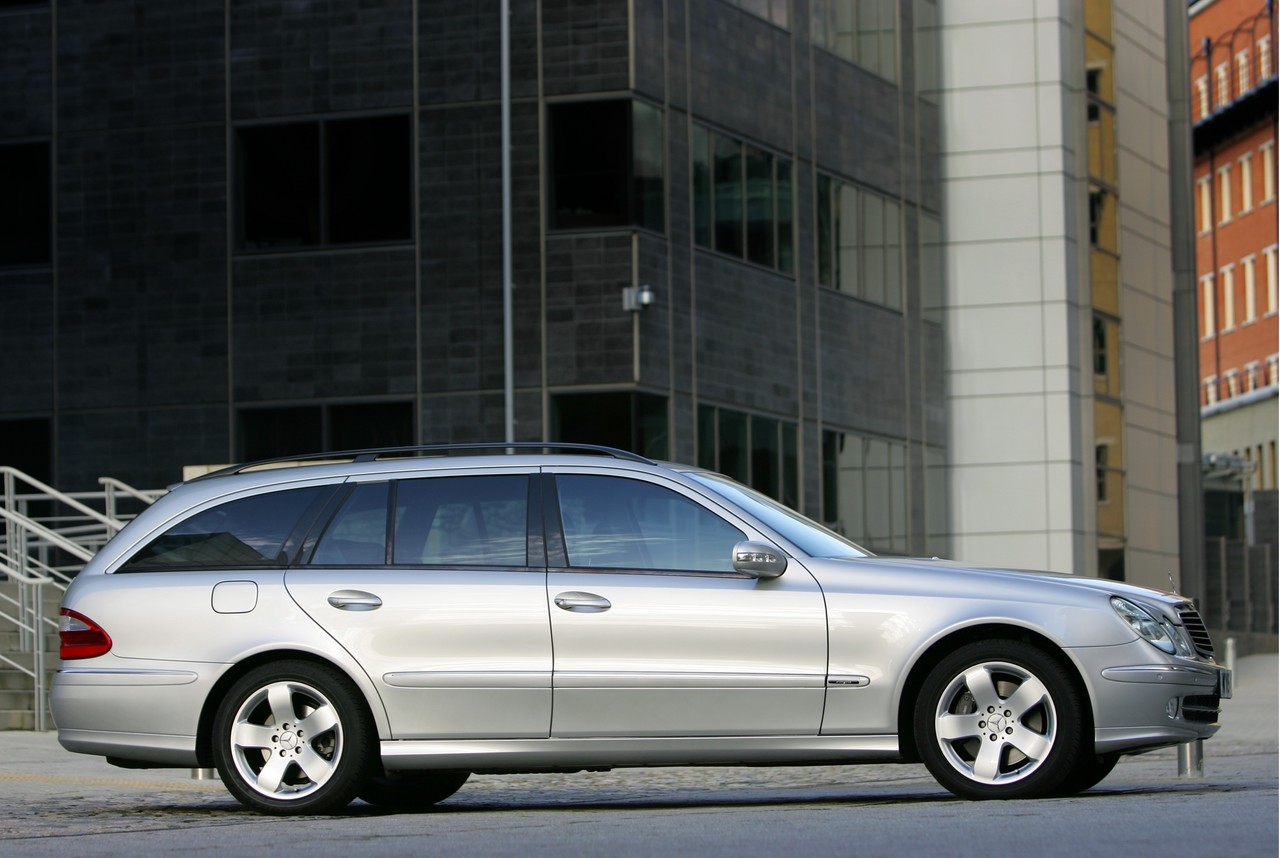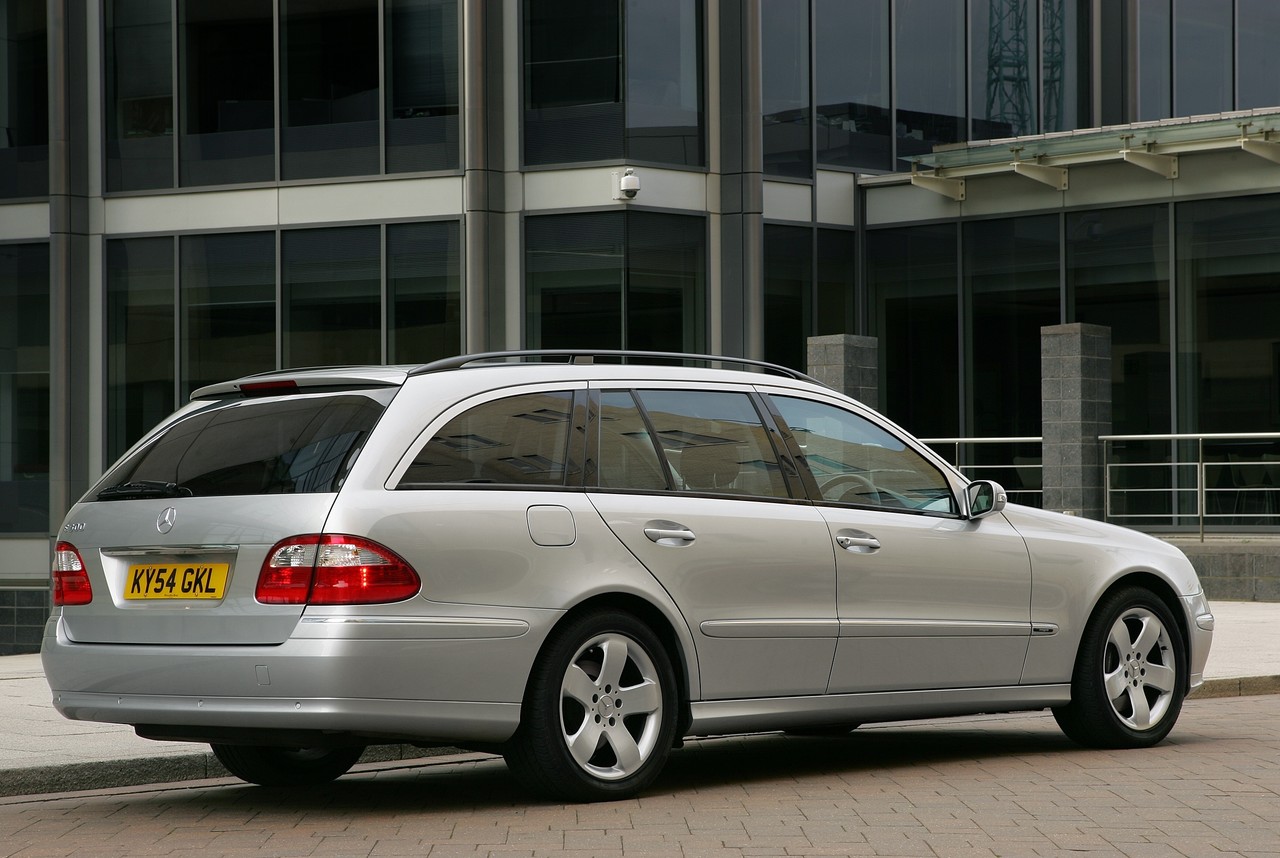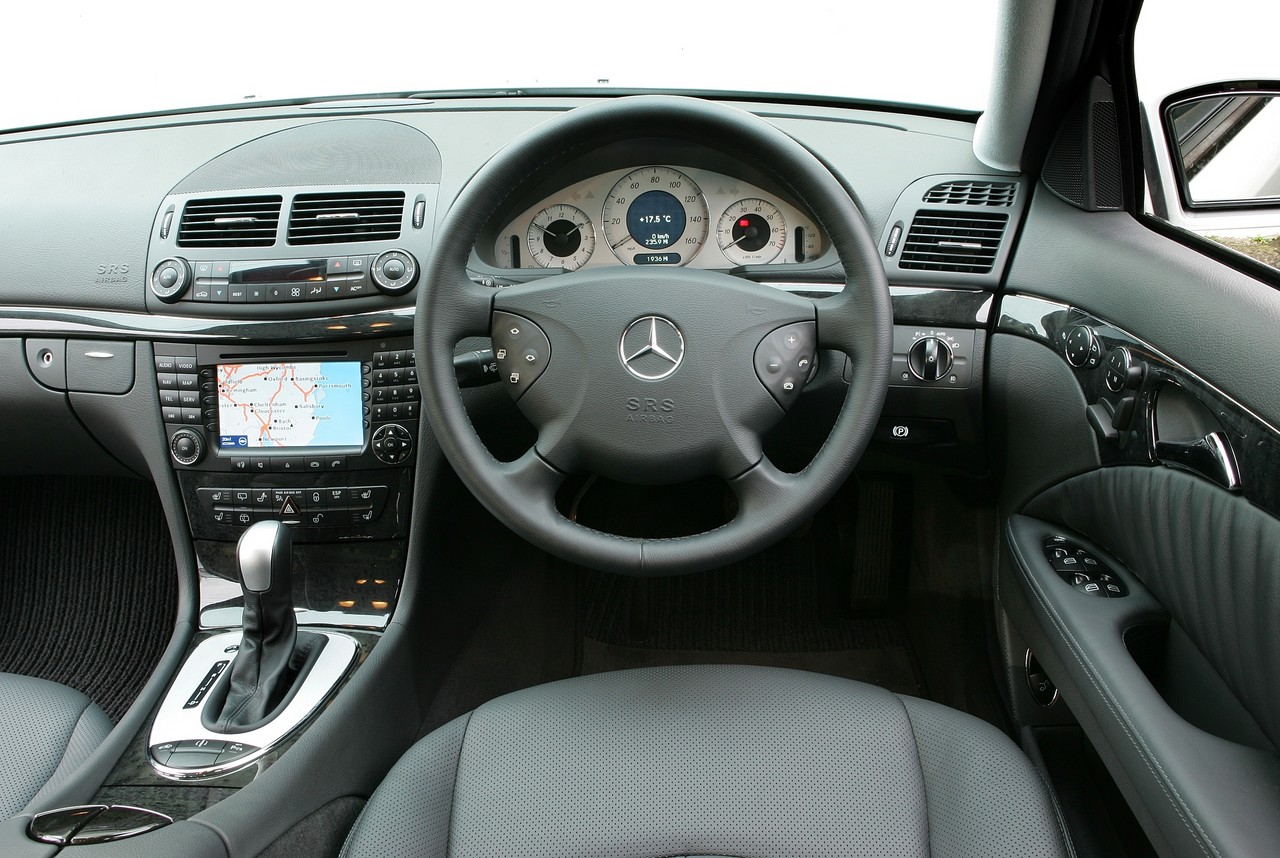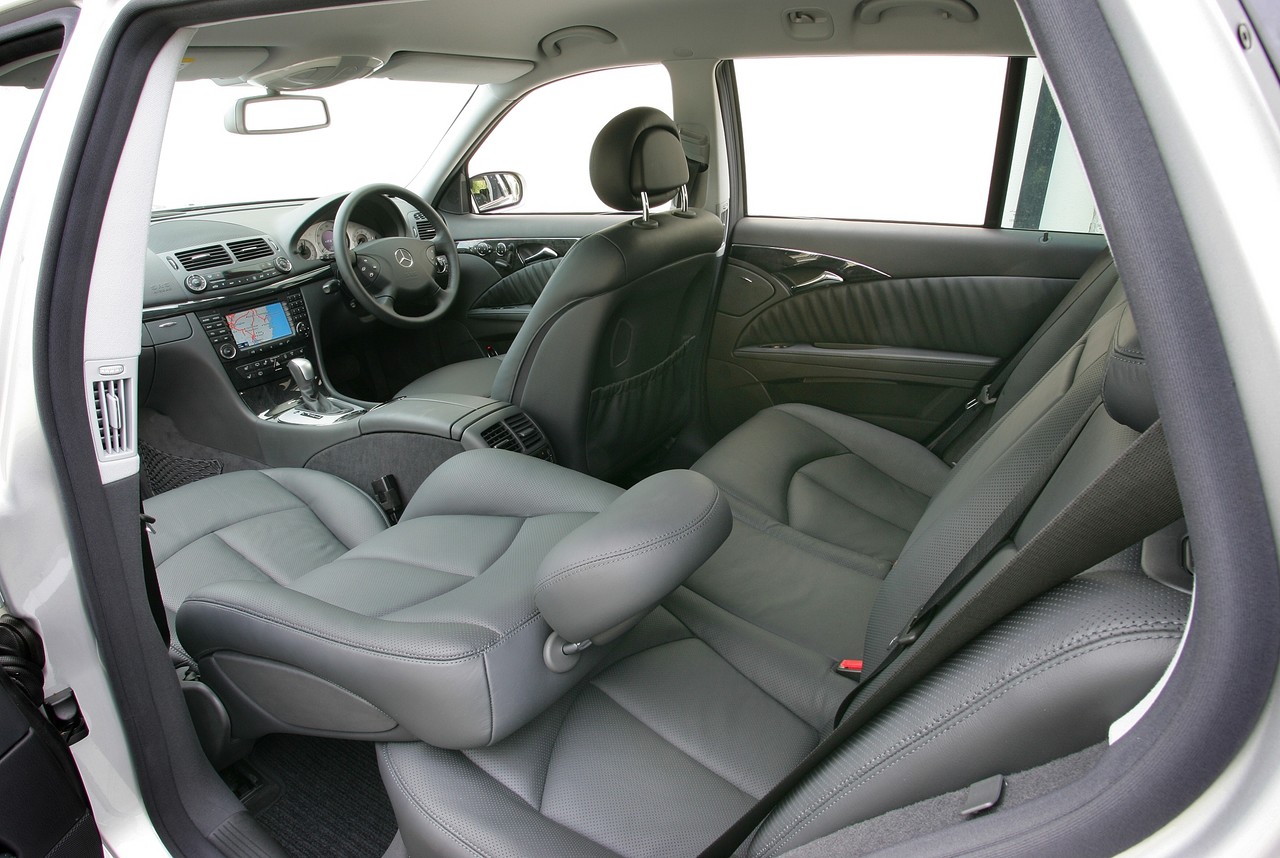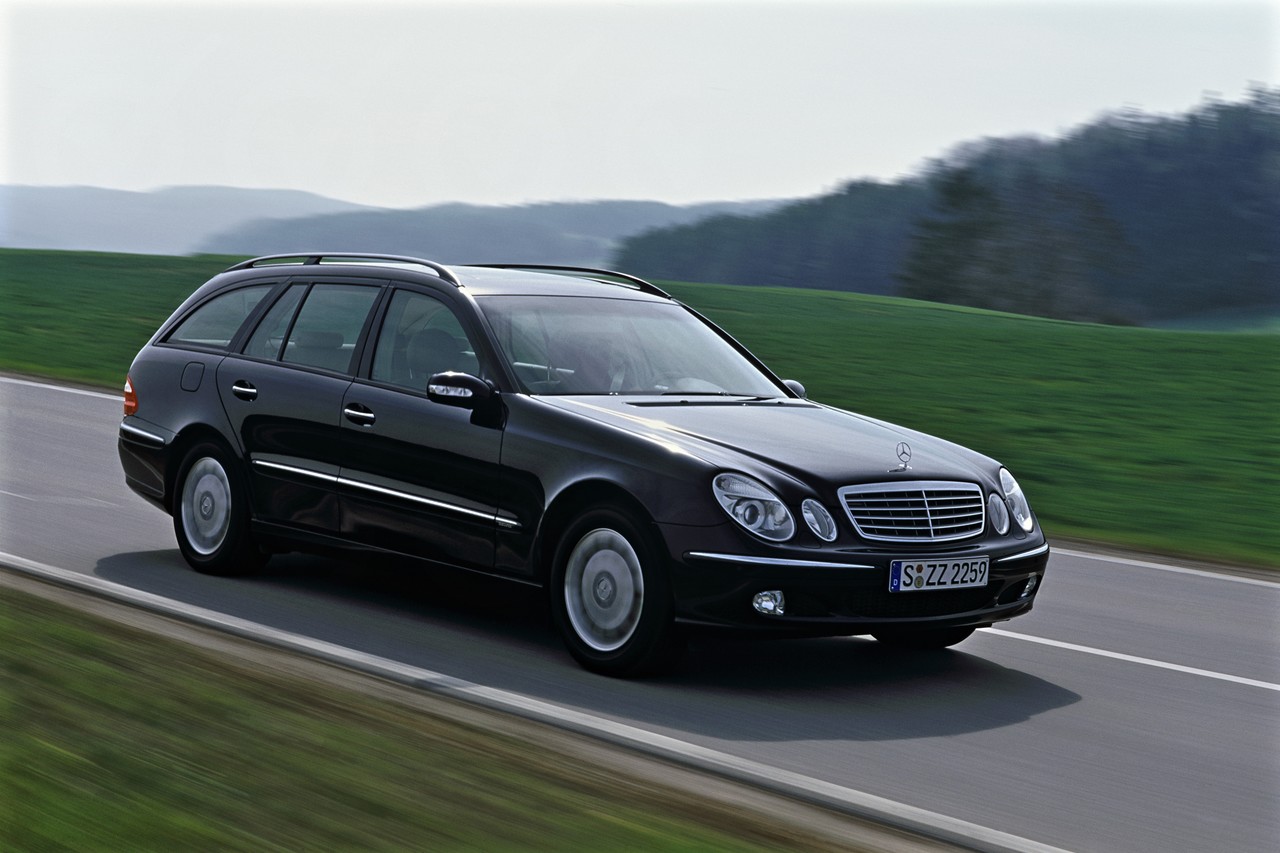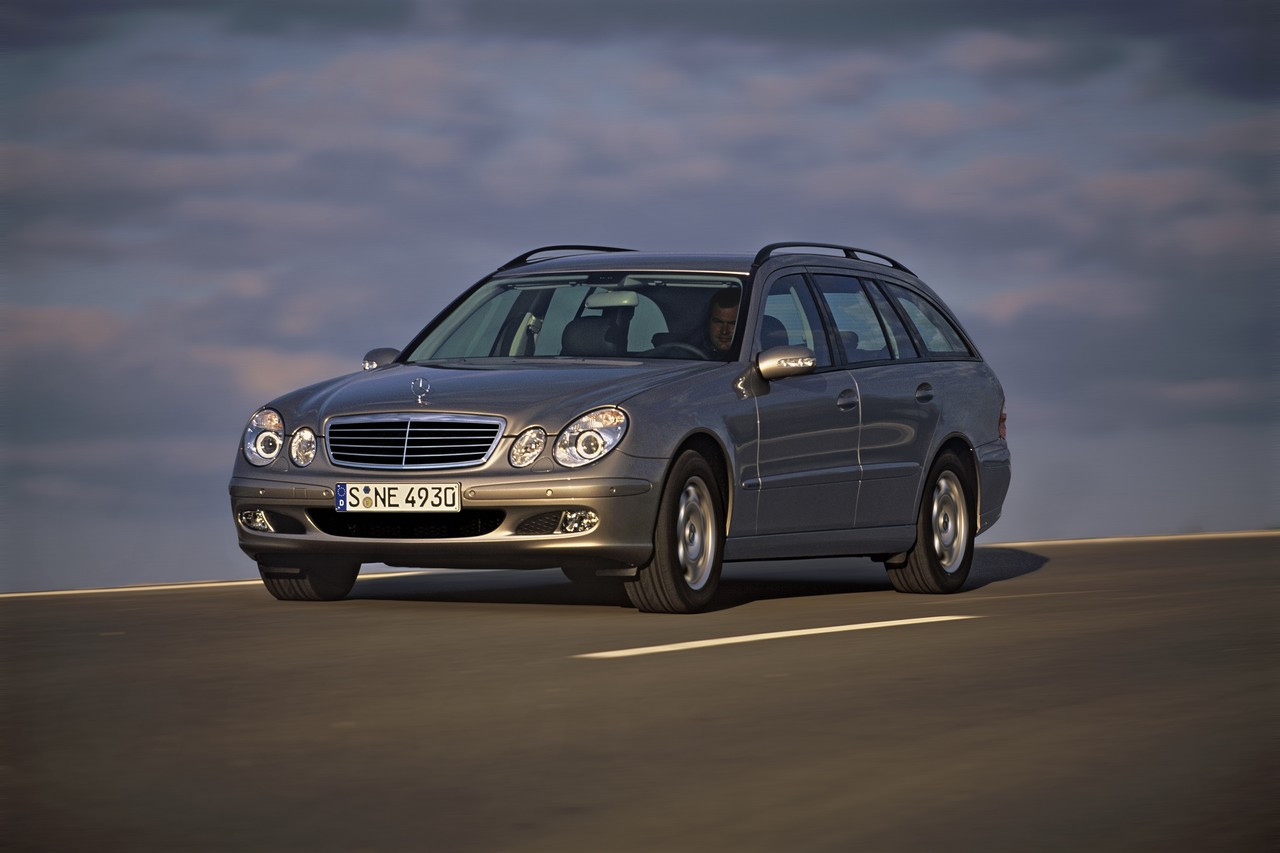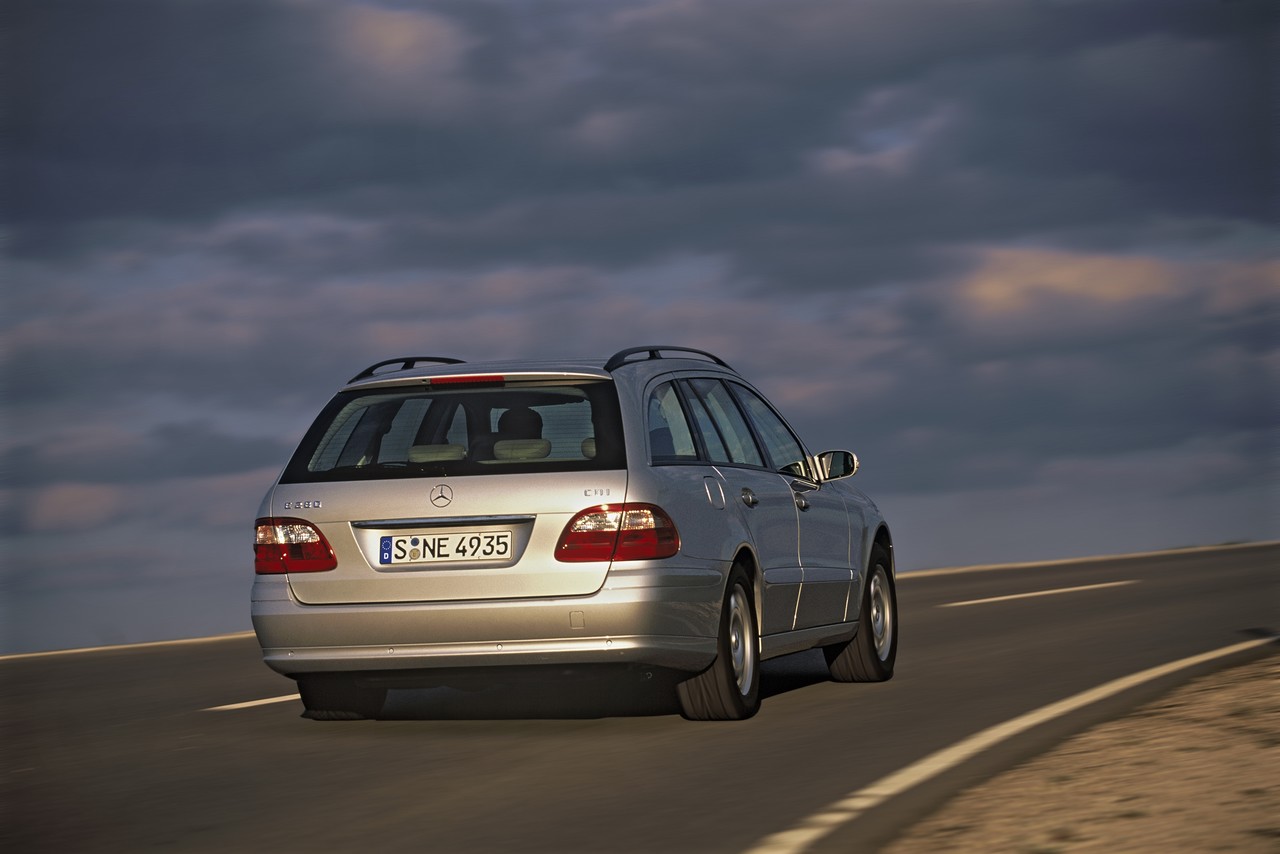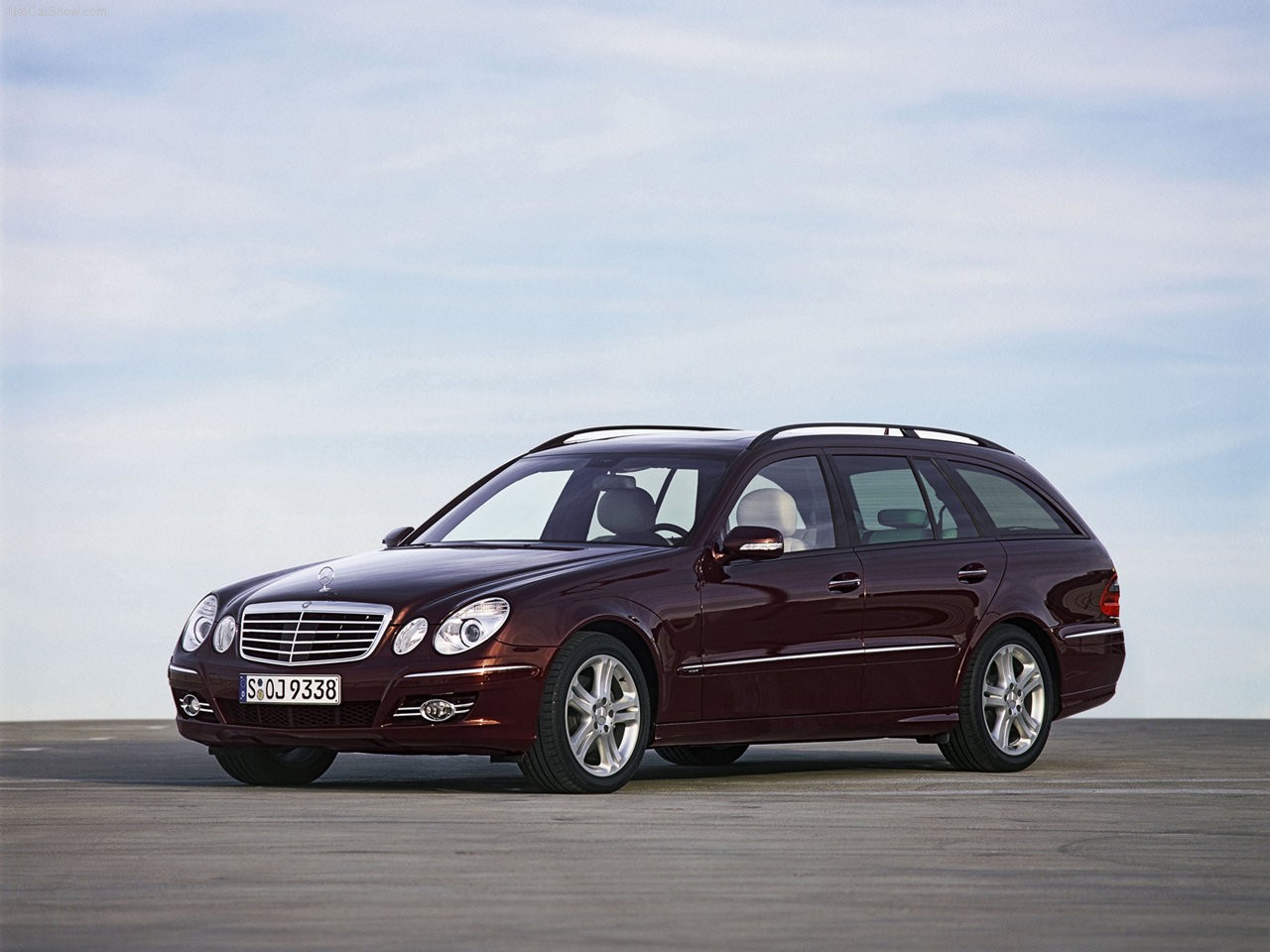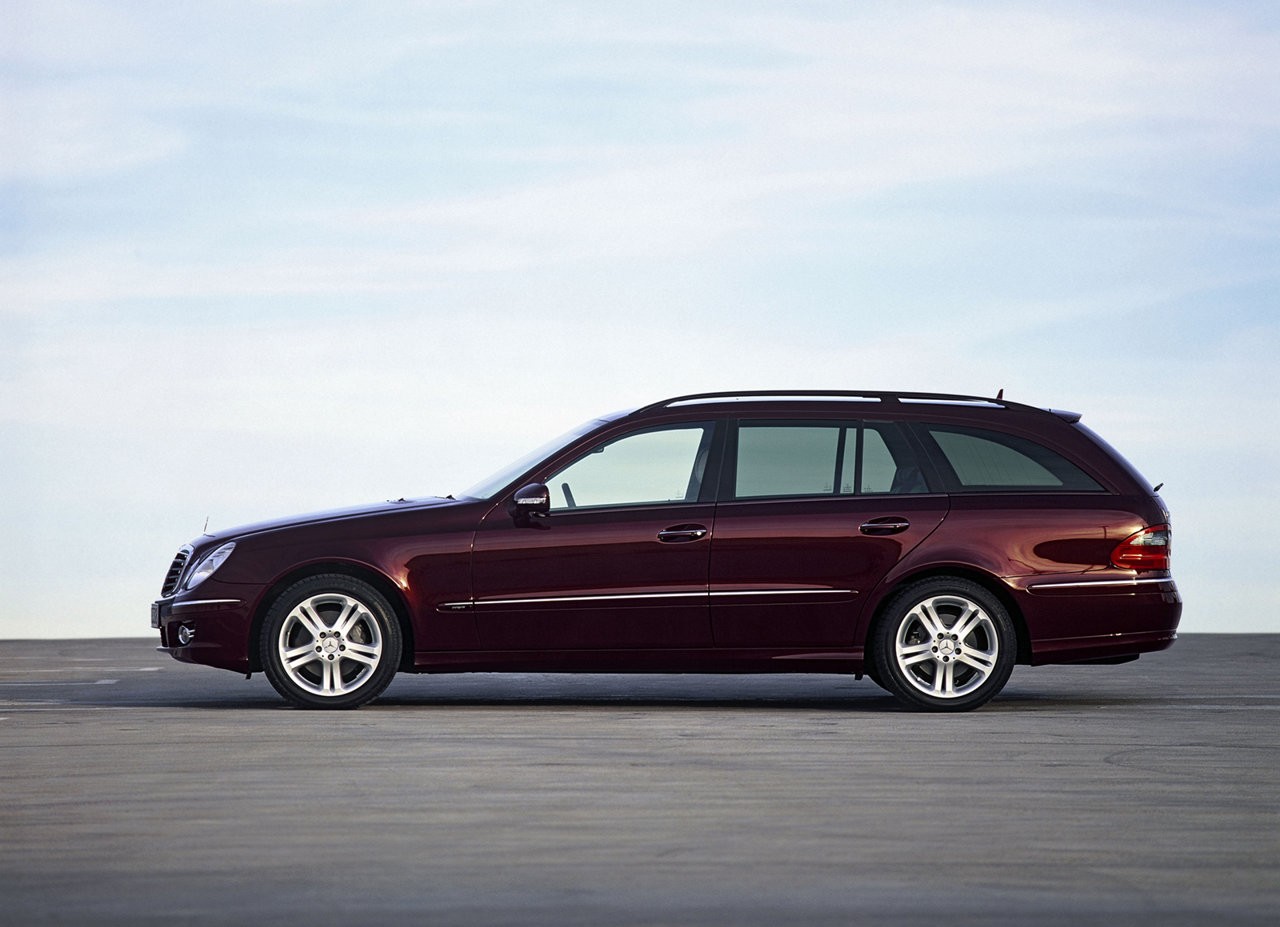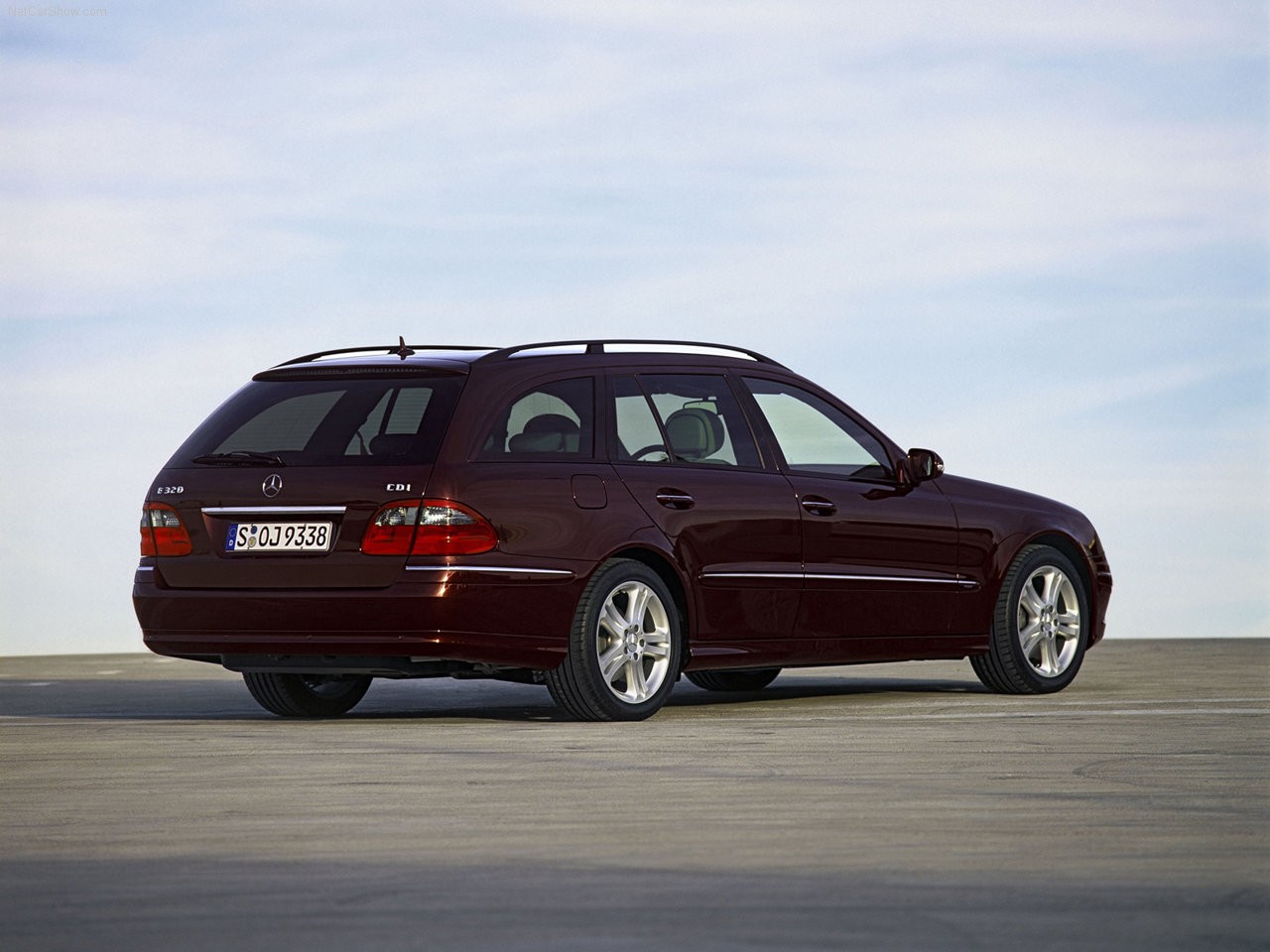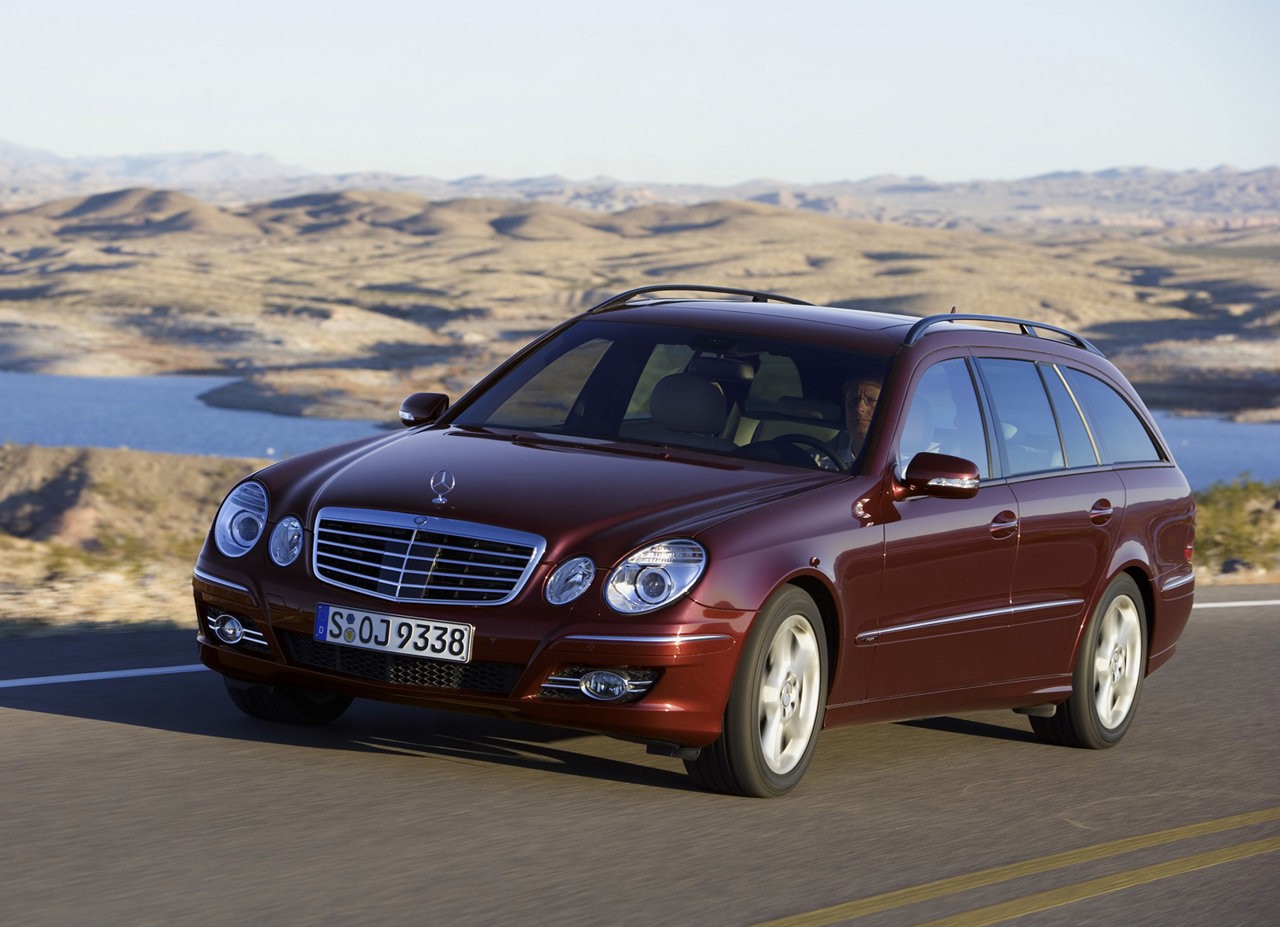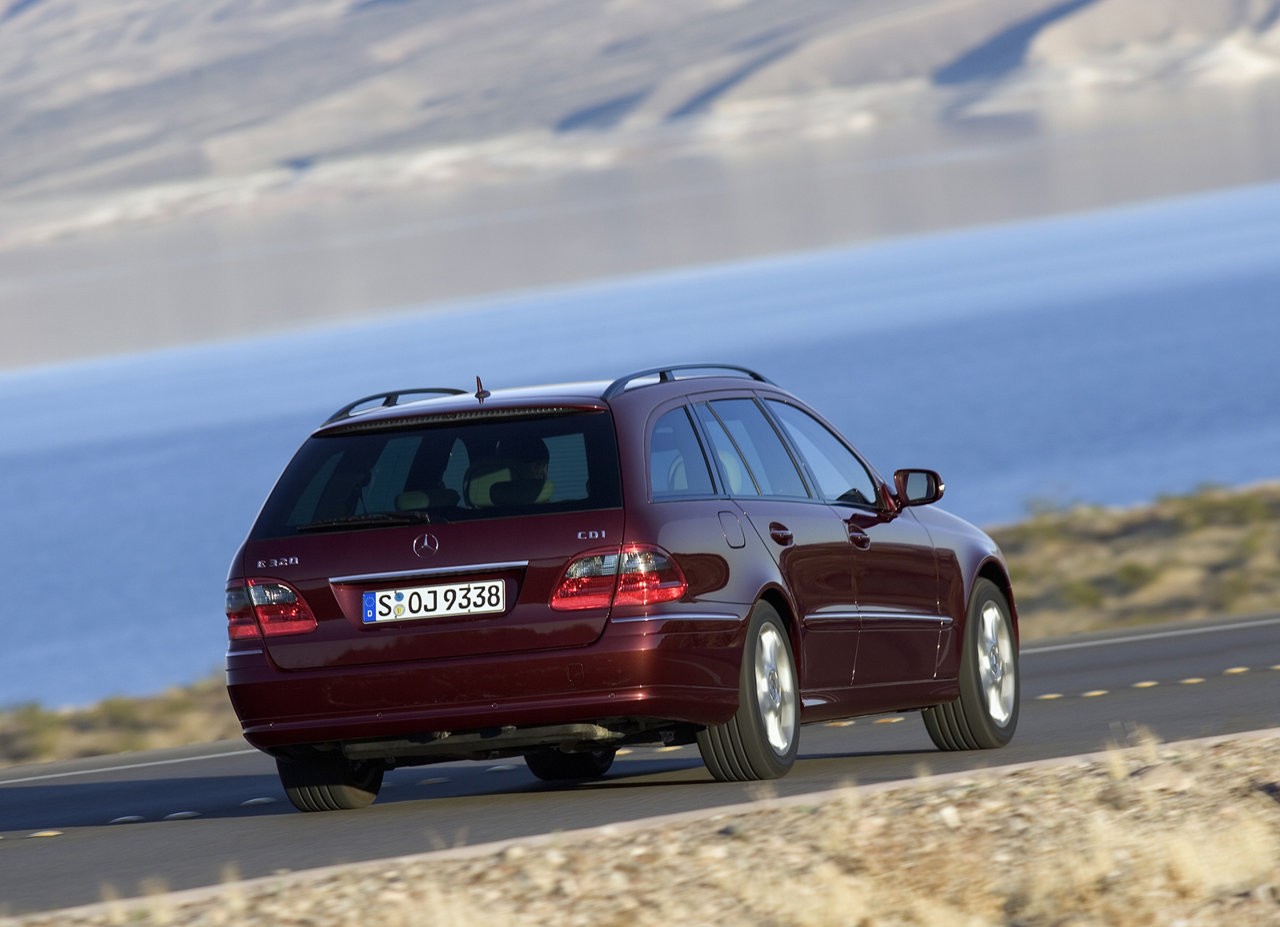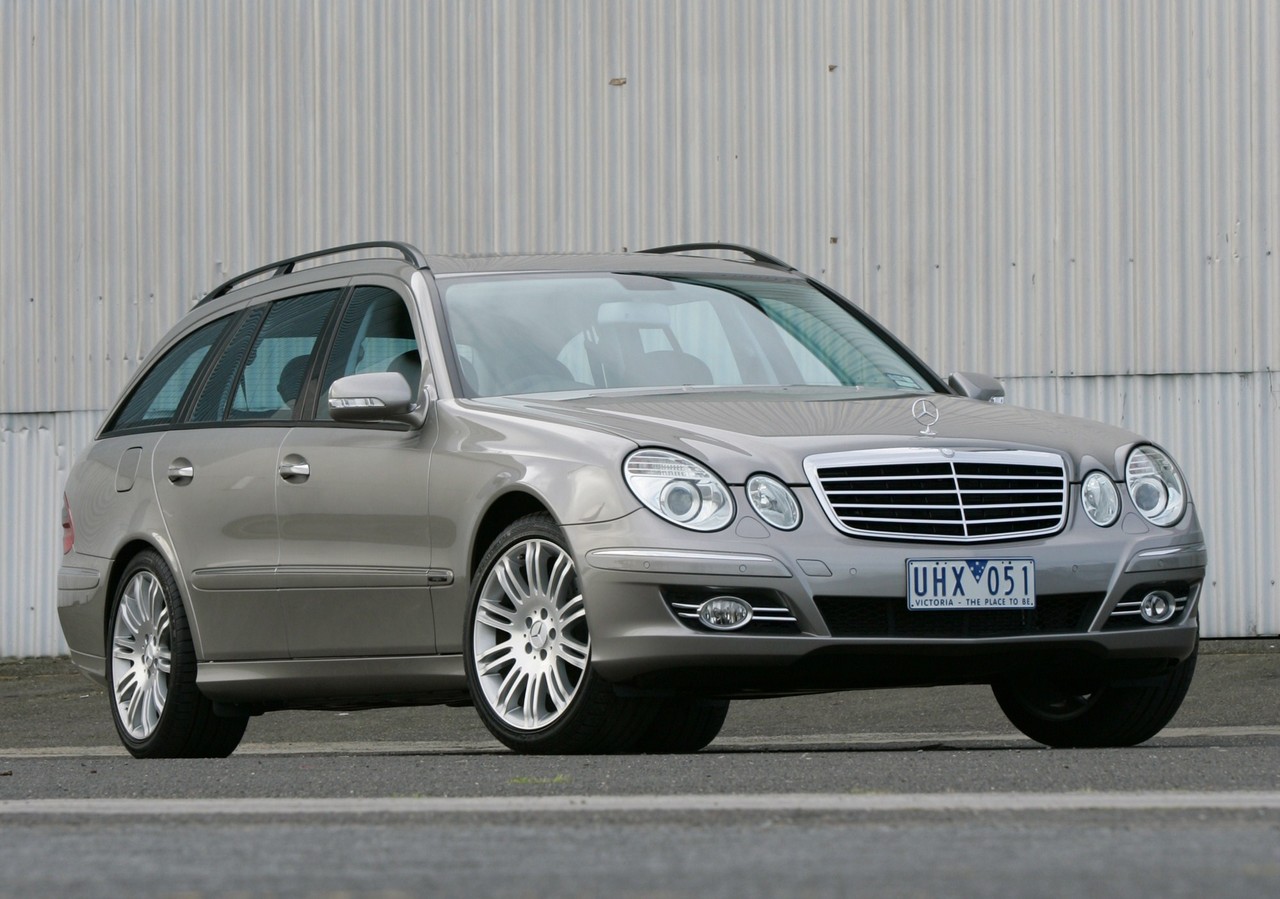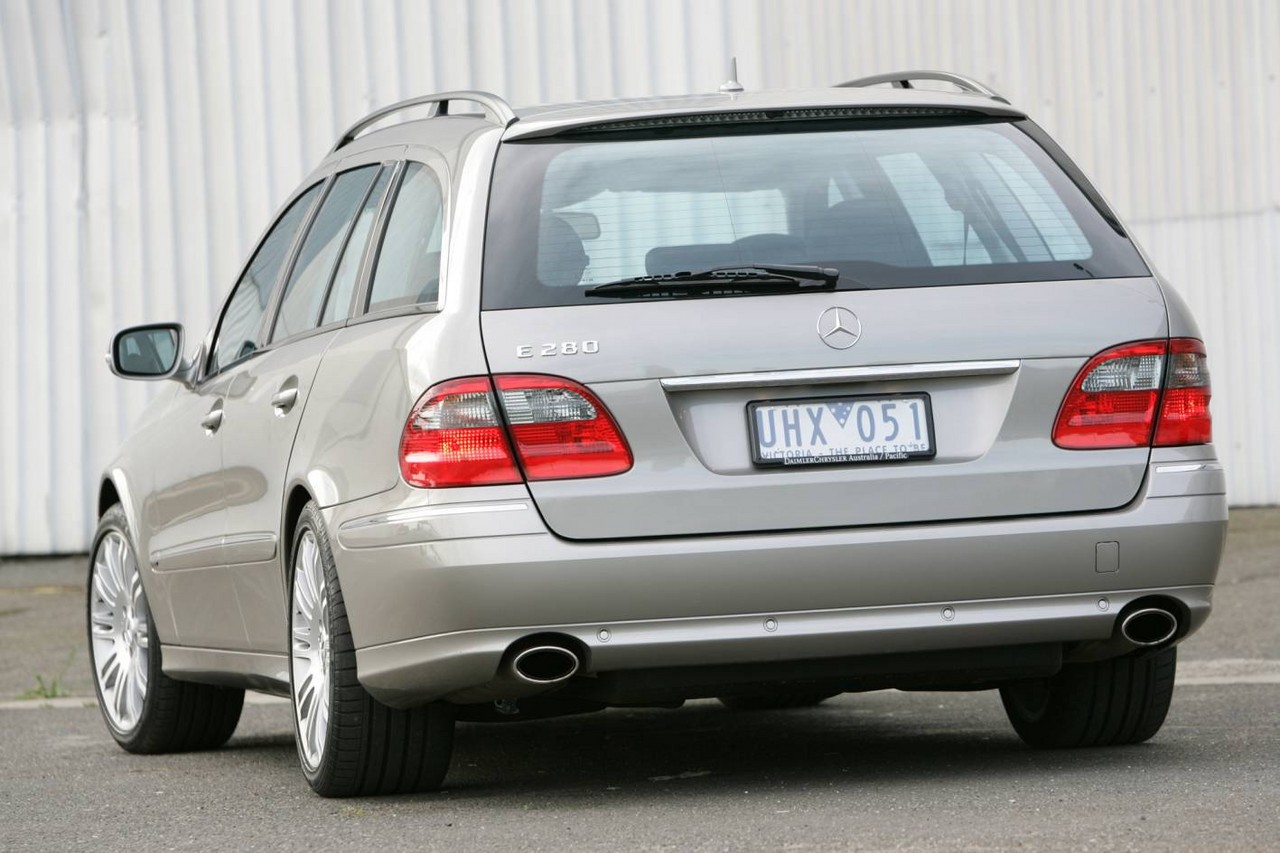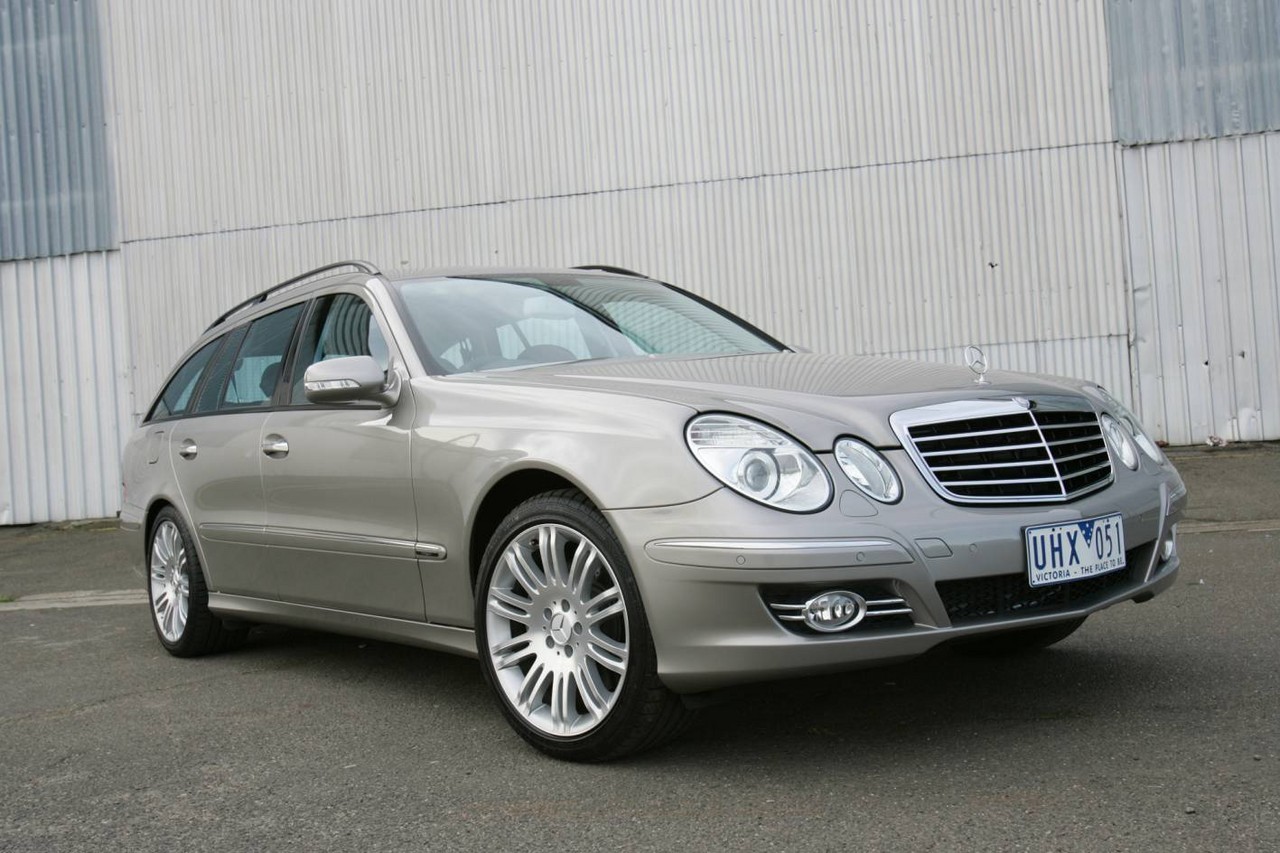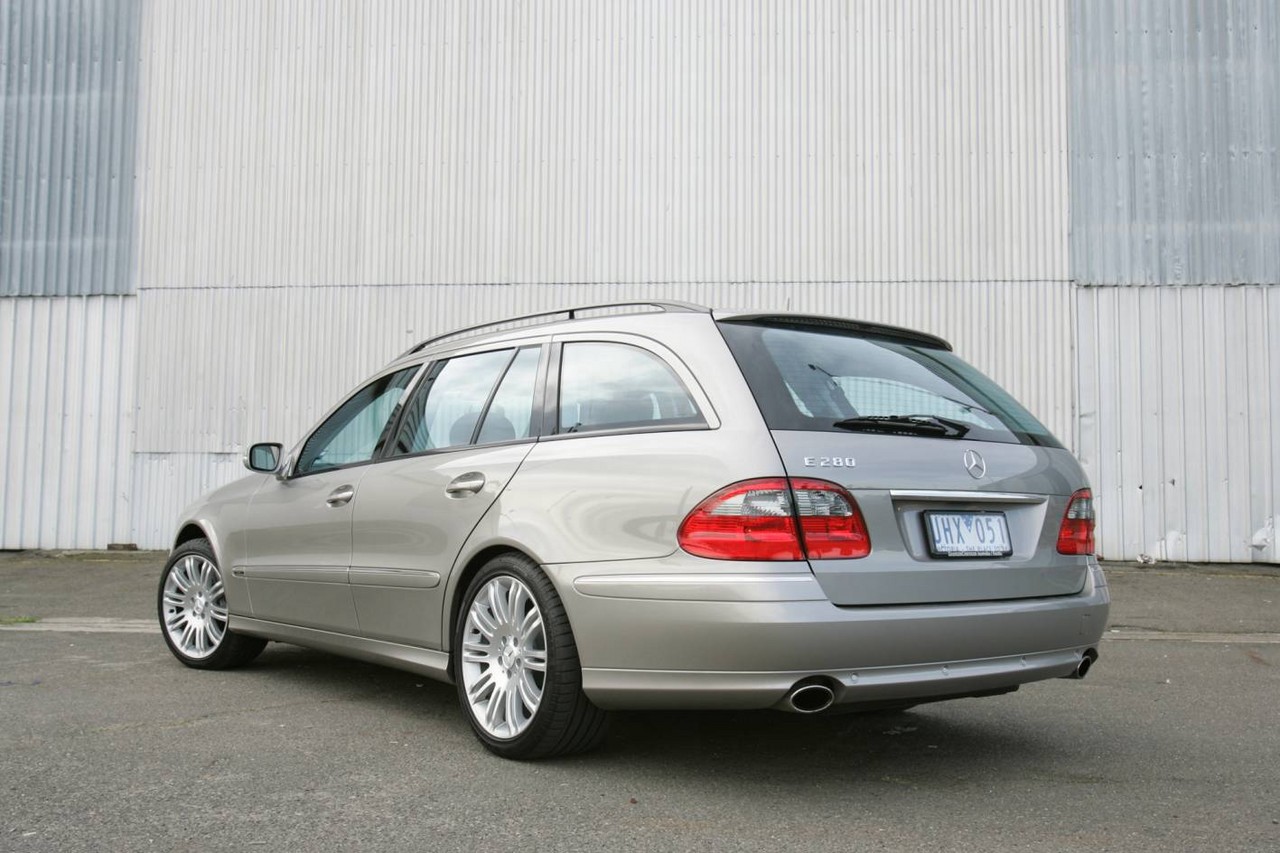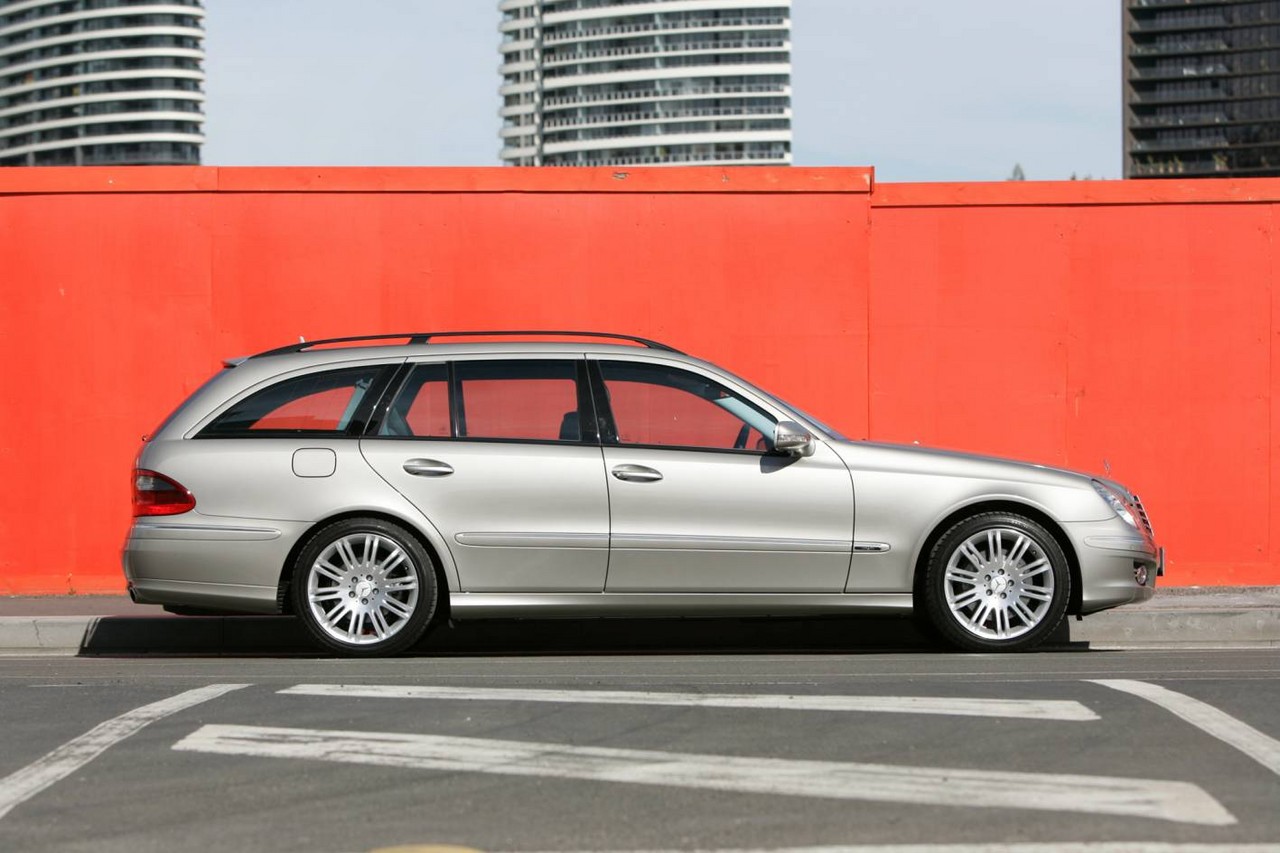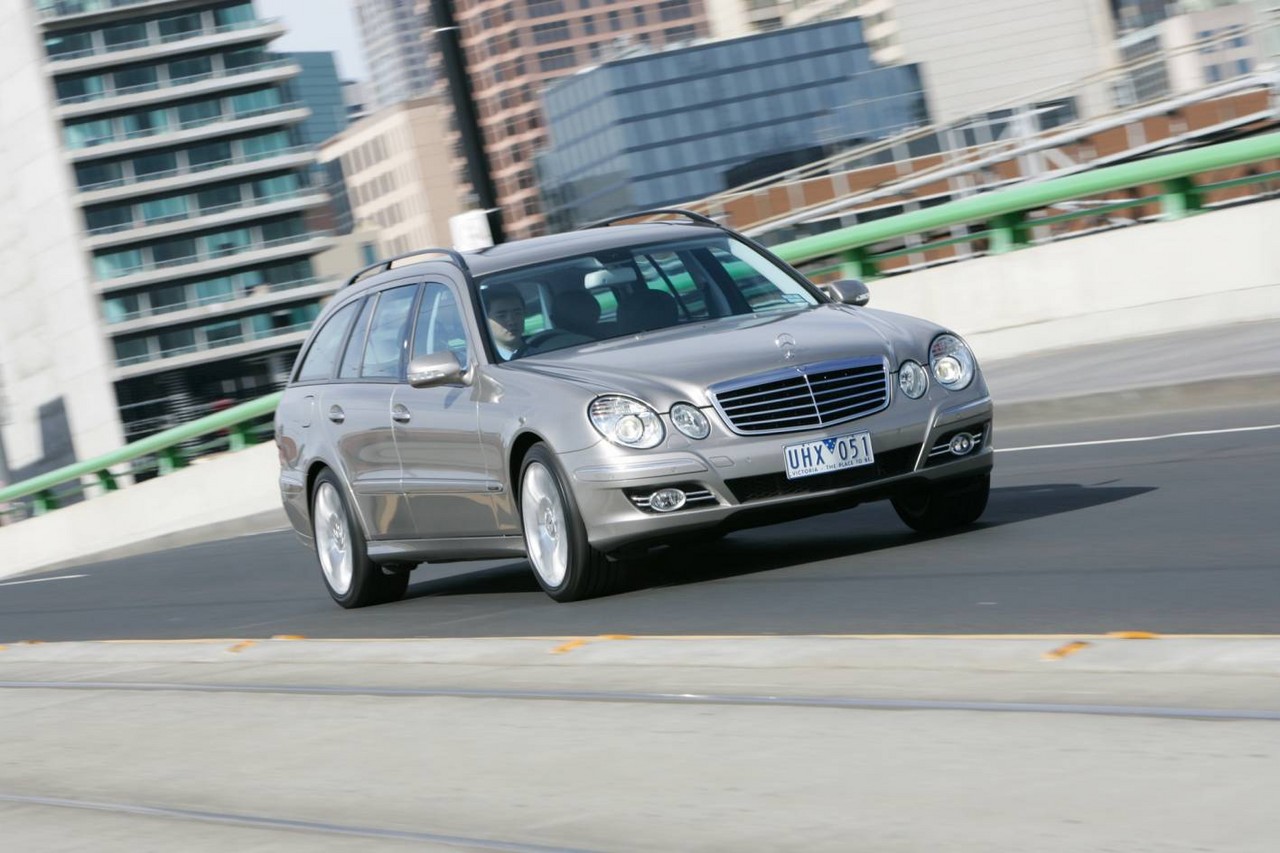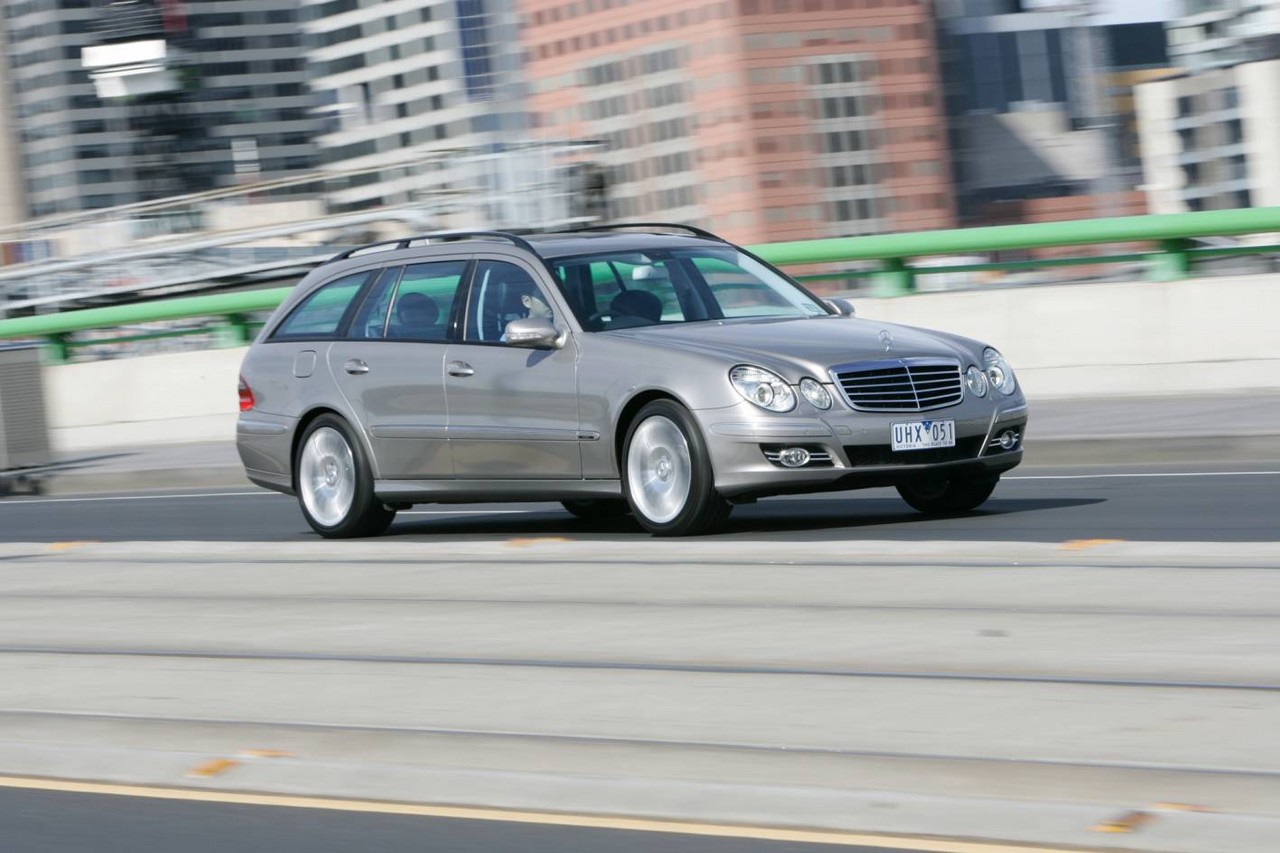
- Refined powertrains
- Excellent ride/handling balance
- Body feels solid and rigid
- Quiet, refined interior
- Underpowered E 200 Kompressor lacks refinement
- Steering wheel vibrations over uneven surfaces
- Handling not as precise and engaging as BMW E61 5-Series Touring
- Pre-September 2006 M272 and M273 V6 engines susceptible to balancer shaft failure
Review: Mercedes-Benz S211.I E-Class Estate (2003-06)
Overview
Released in October 2003, the Mercedes-Benz S211 Series I (S211.I) E-Class Estate was an executive wagon. Manufactured in Germany, the rear-wheel drive S211 E-Class Estate range initially consisted of the E 240 and E 320 models, with the E 500 and E 55 following in April 2004. In September 2005, the E 240 was discontinued and the E 350 replaced the E 320.
| Variant | Years | Engine | Trans. | Peak power | Peak torque | |
|---|---|---|---|---|---|---|
| E 240 | Classic, Avantgarde, Elegance |
2003-05 | 2.6-litre petrol V6 (M112) | 5sp auto | 130 kW at 5700 rpm | 240 Nm at 4500 rpm |
| E 320 | Avantgarde, Elegance |
2003-05 | 3.2-litre petrol V6 (M112 ) | 5sp auto | 165 kW at 5600 rpm | 315 Nm at 3000-4800 rpm |
| E 350 | Avantgarde, Elegance |
2005-06 | 3.5-litre petrol V6 (M272 ) | 7sp auto | 200 kW at 6000 rpm | 350 Nm at 2400-5000 rpm |
| E 500 | Avantgarde, Elegance |
2004-06 | 5.0-litre petrol V8 (M113) | 7sp auto | 225 kW at 5600 rpm | 460 Nm at 2700-4250 rpm |
Dimensions and seats
Compared to the Mercedes-Benz S210 E-Class Estate which preceded it, the S211 E-Class Estate was 21 mm shorter (at 4818 mm), 23 mm wider (1822 mm), 90 mm lower (1452 mm) and had a 21 mm longer wheelbase (2854 mm).
Inside, the S211 E-Class wagon had 60/40 split and flat-folding second row seats and a third row of rear-facing children’s (up to 140cm and 50kg) seats – with height-adjustable head restraints and three-point seatbelts – were fitted in the luggage compartment and could be folded beneath the cargo floor. However, buyers could order a hydraulic loading platform (‘Easy-Pack’) instead of these rear-facing seats which could be extended rearwards by up to 400 mm and used to load objects up to 200kg.
Suspension
Like the W211 E-Class sedan , the S211 E-Class Estate had newly developed four-link front suspension and multi-link independent rear suspension.
Safety equipment
Standard safety equipment for the Mercedes-Benz S211 E-Class Estate included dual front airbags, front and second row side airbags, front and second row curtain airbags, ABS, electronic brake force distribution (Mercedes Benz’s ‘Sensotronic Brake Control’), brake assist, electronic stability control, traction control and front and outer second row seatbelts with pre-tensioners and load limiters. The Sensotronic Brake Control system also included a brake-drying function.
Euro NCAP crash testing
In Euro NCAP crash testing , a 2002 Mercedes-Benz W211 E 220 CDI sedan received a five star adult occupant protection rating with a score of 32.95 out of 37; this result, however, included two points for seatbelt reminders which were not introduced to Australian-delivered models until mid-2004. In the frontal offset crash test, there was a slight risk of serious injury for the front occupants; in the side impact test, there was a slight risk of serious chest injury.
Features: E 240 Estate
Standard features for the Mercedes-Benz S211 E 240 included 16-inch alloy wheels, a ten speaker Audio 20 sound system with a six-disc CD player, climate control air conditioning (‘Thermatic’), ‘twin’ leather upholstery (combination synthetic and genuine leather), power adjustable front seats, cruise control with variable speed limiter (‘Speedtronic’), front and rear fog lamps, automatic headlights, rain-sensing wipers, a multi-function steering wheel, remote central locking, power windows and heated mirrors, a height and reach adjustable steering wheel, tinted windows, trip computer and an immobiliser.
Variants: Classic, Elegance and Avantgarde
In addition to the individual models, the E-Class sedan range was available in a range of variants: Classic, Elegance and Avantgarde. The Classic variants featured six-hole 16-inch alloy wheel designs, ‘calyptus linea’ wood trim and green-tinted thermal insulation glass, while both Elegance and Avantgarde variants were further equipped with interior lighting (with night light), automatically dimming door mirrors with ambient lighting, a leather-wrapped steering wheel and gear shift lever, sun visors with illuminated vanity mirrors, body-coloured door handles, interior-coloured seatbelts and side rub strips with chrome inserts.
Beyond this, the Elegance was distinguished by its thirteen-hole design alloy wheels, brown burr walnut wood trim, instrument cluster with chrome surrounds, chrome bumper strips and high-gloss atlas grey radiator grille with four vanes. The Avantgarde, however, had five-spoke alloy wheel designs, 15 mm lower suspension, combination fabric/leather upholstery, high-pressure headlamp washer system, black bird’s eye maple wood trim, chrome-ringed instruments with white dials, blue-tinted thermal insulation glass, LED brake lights, high-gloss black radiator grille with five vanes, matt chrome gearshift lever panel and side skirts.
Features: E 320, E 350 and E 500 Estate
Compared to the E 240, the E 320 and E 350 added Mercedes-Benz’s COMAND APS (Mercedes-Benz’s Cockpit and Data Management System) with satellite navigation and 6.5-inch colour display (from January 2003), DVD player, dual-zone climate control air conditioning, full leather upholstery, additional front seat adjustment, memory settings (front seats, steering wheel and mirrors) and ‘parameter’ speed-sensitive power steering.
The Mercedes-Benz E 500 Estate featured 17-inch alloy wheels, four-zone climate control air conditioning (‘Thermotronic’), a power-operated glass sunroof and a power adjustable steering column. The E 500 was also fitted with Mercedes-Benz’s Airmatic DC (dual control) air suspension system and Adaptive Damping System, which controlled both springing and damping by monitoring road conditions, driving style and chassis loadings to select optimal shock absorber and spring settings.
February 2005: E-Class Estate update
In February 2005, standard features for the E-Class Estate were extended to include an anti-glare rear view mirror and front and rear parking sensors.
Related links
Review: Mercedes-Benz S211.II E-Class Estate (2006-09)
Overview
Released in September 2006, the Mercedes-Benz S211 Series II (W211.II) E-Class Estate introduced a mechanical upgrades and a subtle facelift. Furthermore, the E 500 was fitted with a 5.5-litre V8 engine (previously a 5.0-litre unit) and all models were fitted with Mercedes-Benz’s 7G-Tronic seven-speed automatic transmission. Other changes included firmer suspension for provided crisper handling, rebound buffer springs to reduce body roll, a faster steering ratio and reduced steering rack rattle.
Visually, the S211.II E-Class Estate could be identified by its deeper V-shaped grille, new bumpers, front fog lights, tail-lights and door mirrors. Inside, there was a new four-spoke steering wheel (shared with the CLS-Class), climate control unit, upholstery and auto-dimming rear view mirror.
| Variant | Years | Engine | Trans. | Peak power | Peak torque | |
|---|---|---|---|---|---|---|
| E 280 | Avantgarde, Elegance |
2006-09 | 3.0-litre petrol V6 (M272) | 7sp auto | 170 kW at 6500 rpm | 300 Nm at 2400 rpm |
| E 280 CDI | Avantgarde, Elegance |
2006-09 | 3.0-litre turbo-diesel V6 (OM642) | 7sp auto | 140 kW at 4750 rpm | 440 Nm at 1400-2800 rpm |
| E 350 | Avantgarde, Elegance |
2006-09 | 3.5-litre petrol V6 (M272) | 7sp auto | 200 kW at 6000 rpm | 350 Nm at 2400-5000 rpm |
| E 500 | Avantgarde, Elegance |
2006-09 | 5.5-litre petrol V8 (M273) | 7sp auto | 285 kW at 6000 rpm | 530 Nm at 2800-4800 rpm |
Safety equipment
Compared to its S211.I predecessor, standard safety equipment for the Mercedes-Benz S211.II E-Class Estate was improved with the introduction of active front seat head restraints (‘NECK-PRO’) and Pre-Safe (which anticipated and prepared for collisions by tensioning the seatbelts, adjusting the front and rear seats and closing the sunroof). Furthermore, the ‘Sensotronic’ braking system was discontinued and replaced with Mercedes-Benz’s ‘Adaptive Brake’ system, which included a hill holder function.
Features
Standard features for the Mercedes-BEnz S211.II E-Class Estate were revised to include a nine speaker sound system, dual-zone climate control air conditioning, mobile phone preparation, a two-part load compartment, tyre pressure monitoring and speed-sensitive power steering.
August 2007: E-Class Estate update
In August 2007, the S212.II E-Class Estate underwent a minor update. Changes included:
- Driver’s seat memory settings were made standard across the range;
- The E63 AMG received directional bi-Xenon headlights and a new AMG performance steering wheel; and,
- Avantgarde variants were fitted with features – as standard – from the optional ‘Sports Package’ such as perforated/vented front brake discs, lowered sports suspension, directional bi-Xenon headlights with dynamic range adjustment, cornering lights and headlight washers.
2008 Mercedes-Benz E-Class Estate: E 280 and E 280 CDI Sports
In July 2008, limited-run Sports editions of the E 280 and E 280 CDI were released. The Sports Edition models were distinguished by their 18-inch alloy wheels with sports suspension, COMAND APS with satellite navigation, steering wheel gearshift paddles, power-operated glass sunroofs and dual chrome exhausts.
Brochures
- Brochure: Mercedes-Benz W211/S211 E-Class (International) (March 2006)
- Brochure: Mercedes-Benz W211/S211 E-Class (International) (March 2008)
Related links
- Specifications: Mercedes-Benz W211.II E-Class Sedan and S211.II E-Class Estate (September 2006)
- Wikipedia.org: Mercedes-Benz W211 E-Class
